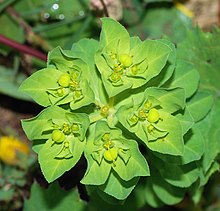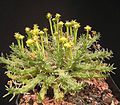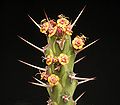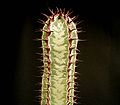Euphorbia
| Euphorbia | |
|---|---|

| |
| Euphorbia serrata | |
| Scientific classification | |
| Kingdom: | Plantae |
| Clade: | Tracheophytes |
| Clade: | Angiosperms |
| Clade: | Eudicots |
| Clade: | Rosids |
| Order: | Malpighiales |
| Family: | Euphorbiaceae |
| Subfamily: | Euphorbioideae |
| Tribe: | Euphorbieae |
| Subtribe: | Euphorbiinae Griseb. |
| Genus: | Euphorbia L. |
| Type species | |
| Euphorbia antiquorum | |
| Subgenera | |
|
| |
| Diversity | |
| c. 2008 species | |
| Synonyms[1] | |
|
List
| |

Euphorbia is a very large and diverse genus of flowering plants, commonly called spurge, in the family Euphorbiaceae. "Euphorbia" is sometimes used in ordinary English to collectively refer to all members of Euphorbiaceae (in deference to the type genus), not just to members of the genus.[2]
Euphorbias range from tiny
Some euphorbias are widely available commercially, such as
Euphorbia all share the feature of having a poisonous,
Etymology
The common name "spurge" derives from the
Description
The plants are
Inflorescence and fruit

This section needs additional citations for verification. (May 2016) |
Like all members of the family Euphorbiaceae, spurges have unisexual flowers.
In Euphorbia, flowers occur in a head, called the
Nectar glands and nectar that attract pollinators are held in the involucre, a cup-like part below and supporting the cyathium head. The "involucre" in the genus Euphorbia is not to be confused with the "involucre" in family Asteraceae members, which is a collection of bracts called
The involucre is above and supported by bract-like modified leaf structures (usually in pairs)[citation needed] called cyathophylls', or cyathial leaves. The cyathophyll often has a superficial appearance of being petals of a flower.
Euphorbia flowers are tiny, and the variation attracting different pollinators, with different forms and colors occurs, in the cyathium, involucre, cyathophyll, or additional parts such as glands that attached to these.
The collection of many flowers may be shaped and arranged to appear collectively as a single individual flower, sometimes called a pseudanthium in the Asteraceae, and also in Euphorbia.
The majority of species are
The female flowers reduced to a single pistil usually split into three parts, often with two stigmas at each tip.[citation needed] Male flowers often have anthers in twos.[citation needed] Nectar glands usually occur in fives,[16] may be as few as one,[16] and may be fused into a "U" shape.[15] The cyathophylls often occur in twos, are leaf-like, and may be showy and brightly coloured and attractive to pollinators, or be reduced to barely visible tiny scales.[citation needed]
The fruits are three- or rarely two-compartment
Xerophytes and succulents
In the genus Euphorbia, succulence in the species has often evolved divergently and to differing degrees. Sometimes, it is difficult to decide, and is a question of interpretation, whether or not a species is really succulent or "only" xerophytic. In some cases, especially with geophytes, plants closely related to the succulents are normal herbs. About 850 species are succulent in the strictest sense. If one includes slightly succulent and xerophytic species, this figure rises to about 1000, representing about 45% of all Euphorbia species.
Irritants
The milky sap of spurges (called "latex") evolved as a deterrent to herbivores. It is white, and transparent when dry, except in E. abdelkuri, where it is yellow. The pressurized sap seeps from the slightest wound and congeals after a few minutes in air. The skin-irritating and caustic effects are largely caused by varying amounts of diterpenes. Triterpenes such as betulin and corresponding esters are other major components of the latex.[17] In contact with mucous membranes (eyes, nose, mouth), the latex can produce extremely painful inflammation. The sap has also been known to cause mild to extreme Keratouveitis, which affects vision.[18] Therefore, spurges should be handled with caution and kept away from children and pets. Wearing eye protection while working in close contact with Euphorbia is advised.[18] Latex on skin should be washed off immediately and thoroughly. Congealed latex is insoluble in water, but can be removed with an emulsifier such as milk or soap. A physician should be consulted if inflammation occurs, as severe eye damage including permanent blindness may result from exposure to the sap.[19]
The poisonous qualities were well known: in the Ethiopian Kebra Nagast, the serpent king Arwe is killed with juice from the Euphorbia.[20]
Uses



Several spurges are grown as garden plants, among them poinsettia (E. pulcherrima) and the succulent E. trigona. E. pekinensis (Chinese: 大戟; pinyin: dàjǐ) is used in traditional Chinese medicine, where it is regarded as one of the 50 fundamental herbs. Several Euphorbia species are used as food plants by the larvae of some Lepidoptera (butterflies and moths), like the spurge hawkmoths (Hyles euphorbiae and Hyles tithymali), as well as the giant leopard moth.
Euphorbias are often used as hedging plants in many parts of Africa.[21]
Misidentification as cacti

Among laypeople, Euphorbia species are among the plant taxa most commonly confused with
Systematics and taxonomy
The present taxon "Euphorbia" corresponds to its own former subtribe, the
Genetic tests have shown that similar flower head structures or forms within the genus, might not mean close ancestry within the genus. The genetic data show that within the genus, convergent evolution of inflorescence structures may be from ancestral subunits that are not related. So using morphology within the genus becomes problematic for further subgeneric grouping. As stated on the Euphorbia Planetary Biodiversity Inventory project webpage:[7]
Previous morphologically based delimitations of subgenera or sections within the genus should not be taken at face value. The genus is in fact rife with striking examples of morphological convergence in cyathial and vegetative features, which justifies a global approach to studying the genus to obtain a proper phylogenetic understanding of the whole group.... The bottom line is that a number of clades have been placed inside or outside of Euphorbia at different times... few of the subgeneric circumscriptions hold up under DNA sequence analysis.
According to a 2002 publication on studies of
Selected species
See List of Euphorbia species for complete list.
- Euphorbia albomarginata – rattlesnake weed, white-margined sandmat
- Euphorbia amygdaloides – wood spurge
- Euphorbia antisyphilitica – candelilla
- Euphorbia balsamifera – sweet tabaiba (Canary Islands)[27]
- Euphorbia bulbispina
- Euphorbia caducifolia – leafless milk hedge[28]
- Euphorbia canariensis – Canary Island spurge, Hercules club (Canary Islands)[29]
- Euphorbia candelabrum – candelabra tree of East Africa
- Euphorbia caput-medusae – Medusa's head (South Africa)
- Euphorbia ceratocarpa – (Sicily and southern Italy)
- Euphorbia characias – Mediterranean spurge
- Euphorbia coerulescens - blue euphorbia [30]
- Euphorbia cotinifolia – copper tree
- Euphorbia cyathophora – fire-on-the-mountain
- Euphorbia cyparissias – Cypress spurge
- Euphorbia decidua
- Euphorbia dendroides – tree spurge
- Euphorbia epithymoides – cushion spurge
- Euphorbia esula – leafy spurge
- Euphorbia franckiana
- Euphorbia fulgens – scarlet plume
- Euphorbia grantii – African milk bush
- Euphorbia gregersenii – Gregersen's spurge
- Euphorbia griffithii – Griffith's spurge
- Euphorbia helioscopia – sun spurge
- Euphorbia heterophylla – painted euphorbia, desert poinsettia, fireplant, paint leaf, kaliko
- Euphorbia hirta – asthma-plant
- Euphorbia hispida
- Euphorbia horrida – African milk barrel
- Euphorbia ingens – candelabra tree
- Euphorbia labatii
- Euphorbia lactea – mottled spurge, frilled fan, elkhorn
- Euphorbia lathyris – caper spurge, paper spurge, gopher spurge, gopher plant, mole plant
- Euphorbia leuconeura – Madagascar jewel
- Euphorbia maculata – spotted spurge, prostrate spurge
- Euphorbia marginata – snow on the mountain
- Euphorbia mammillaris
- Euphorbia maritae
- Euphorbia milii – crown-of-thorns, Christ plant
- Euphorbia misera – cliff spurge, Baja California, Southern California
- Euphorbia myrsinites – myrtle spurge, creeping spurge, donkey tail
- Euphorbia nivulia – leafy milk hedge[31]
- Euphorbia obesa
- Euphorbia paralias – sea spurge
- Euphorbia pekinensis – Peking spurge
- Euphorbia peplis – purple spurge
- Euphorbia peplus – petty spurge
- Euphorbia polychroma– bonfire
- Euphorbia psammogeton – sand spurge
- Euphorbia pulcherrima – poinsettia, Mexican flame leaf, Christmas star, winter rose, noche buena, lalupatae, pascua, Atatürk çiçeği (Turkish)
- Euphorbia purpurea – Darlington's glade spurge, glade spurge, or purple spurge
- Euphorbia resinifera – resin spurge
- Euphorbia rigida – gopher spurge, upright myrtle spurge
- Euphorbia serrata – serrated spurge, sawtooth spurge
- Euphorbia tirucalli – Indian tree spurge, milk bush, pencil tree, firestick
- Euphorbia tithymaloides – devil's backbone, redbird cactus, cimora misha (Peru)
- Euphorbia trigona – African milk tree, cathedral cactus, Abyssinian euphorbia
- Euphorbia tuberosa
- Euphorbia virosa – gifboom or poison tree
Hybrids
Euphorbia has been extensively hybridised for garden use, with many cultivars available commercially. Moreover, some hybrid plants have been found growing in the wild, for instance E. × martini Rouy,[32] a cross of E. amygdaloides × E. characias subsp. characias, found in southern France.
Subgenera
The genus Euphorbia is one of the largest and most complex genera of flowering plants, and several botanists have made unsuccessful attempts to subdivide the genus into numerous smaller genera. According to the recent
- Esula[34]
-
Wood spurge
Euphorbia amygdaloides -
Cypress spurge
Euphorbia cyparissias -
Leafy spurge
Euphorbia esula -
Myrtle spurge
Euphorbia myrsinites
- Rhizanthium
- Chamaesyce[35]
-
Painted euphorbia
Euphorbia heterophylla -
Poinsettia
Euphorbia pulcherrima
- Euphorbia[36]
See also
References
- ^ "Euphorbia L." Plants of the World Online. Board of Trustees of the Royal Botanic Gardens, Kew. 2017. Retrieved 7 July 2020.
- ^ "Definition of Euphorbia". Merriam-Webster Online Dictionary. Merriam-Webster, Inc. Retrieved 1 Feb 2019.
- ^ a b "Euphorbia". Fine Gardening. The Taunton Press, Inc.
- ^ Brenan, J.P.M.; Greenway, P.J. (1949). Check-lists of the Forest Trees and Shrubs of the British Empire #5 - Tanganyika Territory. Oxford, England: Imperial Forestry Institute. p. 214 (part 2).
- ^ Hargreaves, Bruce (n.d.). "Euphorbia ingens in Malawi...etc". Euphorbia Journal. 7: 78 plus diagram p. 63.
- ^ "World Checklist of Selected Plant Families (WCSP)". Kew Science. Royal Botanic Gardens, Kew. Retrieved 16 Apr 2011.
- ^ a b c d e f g h i j "Euphorbia PBI - Project Description". Planetary Biodiversity Inventory (PBI). Retrieved 1 Feb 2019.
- ^ S2CID 27820065.
- ^ "Euphorbia botany lesson". Houzz. 30 Jun 2010. Retrieved 1 Feb 2019.
- ISBN 978-3-540-41966-2.
- ^ "Cacti or Not? Many succulents look like cacti, but are not". CactiGuide.com. Retrieved 1 Feb 2019.
- ^ ISBN 978-0-88496-239-7.
- ^ Linnaeus C (1753). "Euphorbia". Species Plantarum (1st ed.). p. 450.
- ^ Karsten and Schenk , Vegetationsbilder, Volume 15 (1924) Photoplate 6 with caption
- ^ a b "About the genus Euphorbia". Planetary Biodiversity Inventory (PBI). Retrieved 1 Feb 2019.
- ^ a b Stein, G. (22 Apr 2011). "Euphorbia "Flowers," an introduction to the amazing Cyathia". Dave's Garden. Retrieved 1 Feb 2019.
- ^ Hodgkiss, RJ. "Research into euphorbia latex and irritant ingredients". www.euphorbia.de. Retrieved 2 Nov 2013.
- ^ PMID 19574703.
- PMID 10636407.
- ISSN 2194-4024.
- ISBN 9780330536745. Retrieved 6 Oct 2014.
- ^ a b c d Beaulieu, D (21 Oct 2018). "Do You Know the Difference Between Cacti and Succulents?". The Spruce. Dotdash. Retrieved 1 Feb 2019.
- ^ JSTOR 3298591.
- ^ ISSN 2448-7589.
- ^ JSTOR 25065587.
- .
- ^ "Euphorbia balsamifera". Flora de Canarias. Retrieved 1 Feb 2019.
- ^ "Leafless milk hedge". Flowers of India. Retrieved 29 September 2021.
- ^ "Euphorbia canariensis". Flora de Canarias. Retrieved 1 Feb 2019.
- ^ Euphorbia coerulescens
- ^ "Leafy milk hedge". Flowers of India. Retrieved 29 September 2021.
- ^ "World Checklist of Selected Plant Families (WCSP) - Euphorbia × martini Rouy, Ill. Pl. Eur. 13: 107 (1900)". Kew Science. Royal Botanic Gardens, Kew. Retrieved 26 Feb 2018.
- S2CID 22055432.
- doi:10.12705/622.3.
- hdl:2027.42/146846.
- S2CID 87352157.
Further reading
- Buddensiek V (2005). Succulent Euphorbia plus (CD-ROM). Volker Buddensiek Verlag.
- Carter S (1982). New Succulent Spiny Euphorbias from East Africa. Hooker's Icones plantarum. ISBN 9781878762726.
- Carter S, Eggli U (1997). The CITES Checklist of Succulent Euphorbia Taxa (Euphorbiaceae). Germany: German Federal Agency for Nature Conservation. ISBN 9783896246097.
- Carter S, Smith AL (1988). "Euphorbiaceae". Flora of Tropical East Africa. Royal Botanic Gardens, Kew.
- Noltee F (2001). Succulents in the wild and in cultivation, Part 2 Euphorbia to Juttadinteria (CD-ROM).
- Urs E, ed. (2002). Sukkulenten-Lexikon (in German). Vol. 2: Zweikeimblättrige Pflanzen (Dicotyledonen). Eugen Ulmer Verlag. ISBN 9783800139156.
- Gómez-Valcárcel M, Fuentes-Páez G (2016). "Euphorbia grandicornis Sap Keratouveitis: A Case Report". PMID 27293414.
- Everitt J, Lonard R, Little C (2007). Weeds in South Texas and Northern Mexico. Lubbock: Texas Tech University Press. ISBN 9780896726147.
- Pritchard A (2003). Introduction to the Euphorbiaceae (in Italian). Cactus & Co. ISBN 9788890051142.
- Schwartz H, ed. (1983). The Euphorbia Journal. Mill Valley, CA: Strawberry Press.
- Singh M (1994). Succulent Euphorbiaceae of India. India: Meena Singh (self published). ASIN B004PFR2G6.
- ISBN 9780881923308.
- Soumen A (2010). "A revision of geophytic euphorbia species from India" (PDF). Euphorbia World. 6 (1): 18–21. ISSN 1746-5397.
- Pritchard A (2010). Monadenium. Venegono Superiore: Cactus & Co. ISBN 9788895018027.
External links
 Media related to Euphorbia at Wikimedia Commons
Media related to Euphorbia at Wikimedia Commons- . Encyclopædia Britannica. Vol. 9 (11th ed.). 1911.
- International Euphorbia Society
- IPNI

















